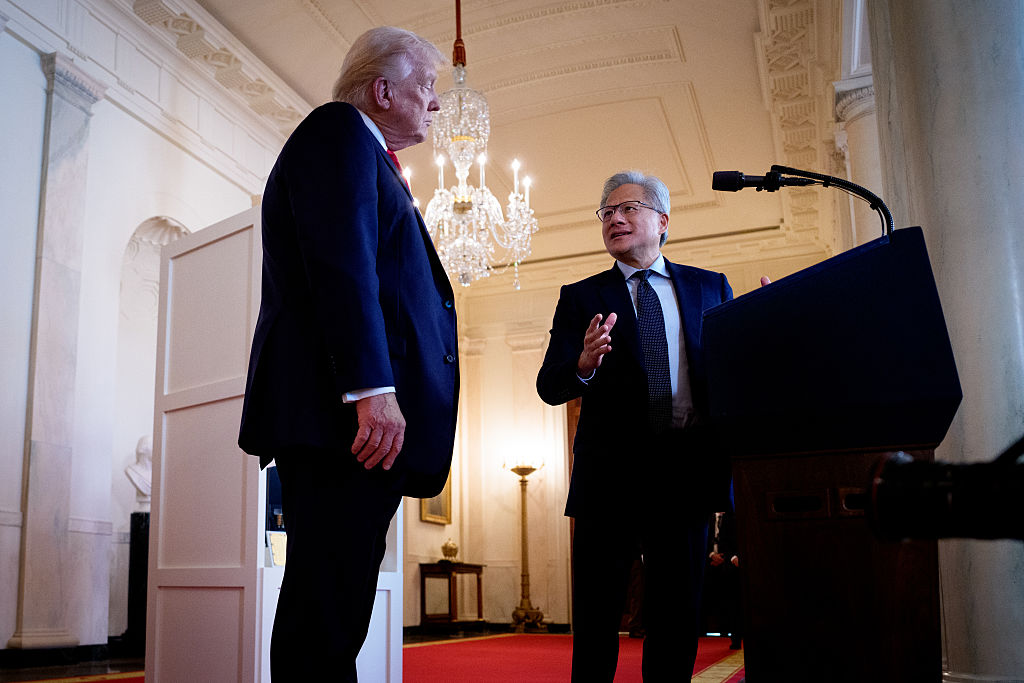Nvidia’s shares rise on Trump’s China chip concession
The lucrative Chinese market may be back in play for Nvidia as Donald Trump signals H200 chip exports could be permitted


Nvidia’s share price rose following hints from US president Donald Trump that he could permit the company to resume sales of certain chips to Chinese companies.
Trump posted on his social media platform Truth Social that he had told China’s President Xi Jinping that Nvidia would be allowed to ship its H200 artificial intelligence (AI) chips to China despite US restrictions on critical tech exports to its geopolitical rival.
Trump restricted the sale even of chips like the H20, which had been specifically designed to circumvent these controls, earlier this year, prompting Nvidia’s CEO Jensen Huang to bemoan that “the $50 billion China [chip] market is effectively closed to US industry” during the company’s Q1 earnings call in May.
MoneyWeek
Subscribe to MoneyWeek today and get your first six magazine issues absolutely FREE

Sign up to Money Morning
Don't miss the latest investment and personal finances news, market analysis, plus money-saving tips with our free twice-daily newsletter
Don't miss the latest investment and personal finances news, market analysis, plus money-saving tips with our free twice-daily newsletter
Like the H20 chip, the H200 is less powerful than the latest generation of GPUs that Nvidia sells to customers outside China.
Shares in Nvidia (NASDAQ:NVDA) gained 1.7% on 8 December. After rising in after-hours trading following Trump's announcement, Nvidia's shares then fell back 0.5% inside the opening hour of regular trading the following day.
“Donald Trump is back stirring the chip pot again, claiming Nvidia’s H200 chip is cleared for sale to China,” said Matt Britzman, senior equity analyst at Hargreaves Lansdown.
Trump also suggested that the US government will take a 25% sales tax on any chips sold to China, up from 15% previously.
Nvidia’s share price has gained 38% in 2025 as of close on 8 December, a run that helped make Nvidia the world’s first $4 trillion company.
How much could China shipments make for Nvidia?
China’s technology industry is potentially a big source of revenue for Nvidia, especially given Huang’s estimate of its $50 billion valuation.
Some analysts estimated that sales to China could add $15-25 billion to Nvidia’s revenue next year, though Britzman believes it is “far too early” to bake numbers like this into projections.
There are two variables, the first of which is demand for Nvidia’s H200 chips from Chinese companies. These are six times as powerful as the H20 that Nvidia was previously barred from exporting, according to the Institute for Progress, despite lagging behind the cutting edge Blackwell GPUs that will be reserved for US customers.
“Given the significant performance upgrade H200s represent vs. NVDA's H20… we believe China CSPs should have meaningful demand for the accelerators assuming unfettered access,” said Matt Bryson, managing director, equity research at Wedbush Securities.
But unfettered access – the second variable – is likely to be the challenge, despite Trump’s latest announcement.
“With the China government having previously blocked/dissuaded Chinese customers from buying US technology, we are somewhat cautious in believing China will approve of chip sales,” said Bryson.
The FT reported on 9 December that the Chinese government is likely to restrict the ability of Chinese firms to import H200 chips so as to encourage its own domestic chipmaking industry, citing two unnamed people with knowledge of the matter.
Can Nvidia keep increasing its earnings?
The bull thesis for Nvidia is that AI is going to transform every facet of life and business, and that all of this value created will feed into Nvidia’s bottom line.
“With AI infrastructure investments continuing to grow with the company expecting between $3 trillion to $4 trillion in total AI infrastructure spend by the end of the decade, the chip landscape remains Nvidia’s world with everybody else paying rent,” said Dan Ives, head of global technology research at Wedbush Securities.
But detractors will point out that this thesis falls apart if Nvidia’s profit growth ever underwhelms. “Any chink in [Nvidia’s] profits is likely to be taken very badly by the market,” says Ed Monk, associate director at Fidelity International.
Nvidia's year-over-year revenue growth slowed from over 250% two years ago to 53.5% in Q2 this year (note that Nvidia’s financial year is, effectively, one year ahead of the calendar year). There was clearly an impact in Q2 from the lost China chip sales – and despite this, Nvidia’s latest earnings showed a strong rebound to 62% growth – but Nvidia’s growth curve has clearly flattened over the last two years.
This flattening of revenue growth is inevitable as companies grow, but it is part of the reason why markets pay close attention to the numbers that Nvidia puts up relative to expectations.
In this context, revenue drivers like the China market take on huge importance for anyone considering buying Nvidia’s shares. If the Chinese market is closed off to Nvidia over the long term, it could dent the kind of revenue and profit growth that underpins the investment thesis for Nvidia.
Are Nvidia’s shares good value?
Nvidia’s shares currently trade at 45 times trailing earnings, and 30 times its expected earnings over the next 12 months, according to data from Yahoo Finance (as of US market close on 8 December).
These are some of the lowest multiples that Nvidia’s stock has traded at in years, and reflects investor jitters over the long-term sustainability of AI spend and the danger that the AI bubble could burst.
Bulls will argue that this is a more than reasonable price to pay for such a successful company, but as the perceived leader of the AI boom, Nvidia’s shares often bear the brunt when investor confidence wanes.
It also faces increasing levels of competition to what has for years looked like an effective monopoly on top-end AI chips. Rival AMD will also be allowed to sell its chips to China based on Trump’s latest policy announcement, and Google has recently launched its own AI chip, the tensor processing unit, which has powered superior performance in its latest Gemini model.
For investors looking for other means of exposure, there are various ways to find value in AI without having to pay the steep valuations that Nvidia commands.
Get the latest financial news, insights and expert analysis from our award-winning MoneyWeek team, to help you understand what really matters when it comes to your finances.

Dan is a financial journalist who, prior to joining MoneyWeek, spent five years writing for OPTO, an investment magazine focused on growth and technology stocks, ETFs and thematic investing.
Before becoming a writer, Dan spent six years working in talent acquisition in the tech sector, including for credit scoring start-up ClearScore where he first developed an interest in personal finance.
Dan studied Social Anthropology and Management at Sidney Sussex College and the Judge Business School, Cambridge University. Outside finance, he also enjoys travel writing, and has edited two published travel books.
-
 ‘Why I have ditched my Help to Buy ISA for cash savings and the stock market’
‘Why I have ditched my Help to Buy ISA for cash savings and the stock market’Without the 25% bonus, my Help to Buy ISA is effectively redundant, says MoneyWeek writer Sam Walker.
-
 Is your inheritance tax allowance cut if you sell to downsize or sell your home to pay for care?
Is your inheritance tax allowance cut if you sell to downsize or sell your home to pay for care?Downsizing relief is a little-known benefit that could save your loved ones tens of thousands of pounds in inheritance tax after you’ve died.
-
 Metals and AI power emerging markets
Metals and AI power emerging marketsThis year’s big emerging market winners have tended to offer exposure to one of 2025’s two winning trends – AI-focused tech and the global metals rally
-
 Quality emerging market companies with consistent returns
Quality emerging market companies with consistent returnsOpinion Mark Hammonds, portfolio manager at Guinness Global Investors, selects three emerging market stocks where he'd put his money
-
 Coreweave is on borrowed time
Coreweave is on borrowed timeAI infrastructure firm Coreweave is heading for trouble and is absurdly pricey, says Matthew Partridge
-
 An AI bust could hit private credit – could it cause a financial crisis?
An AI bust could hit private credit – could it cause a financial crisis?Opinion Private credit is playing a key role in funding data centres. It may be the first to take the hit if the AI boom ends, says Cris Sholto Heaton
-
 The top stocks of 2025 - did you pick a winner?
The top stocks of 2025 - did you pick a winner?As a chaotic year in the stock market draws to a close, we review which stocks were investors’ top picks for 2025
-
 Why Trustpilot is a stock to watch for exposure to the e-commerce market
Why Trustpilot is a stock to watch for exposure to the e-commerce marketTrustpilot has built a defensible position in one of the most critical areas of the internet: the infrastructure of trust, says Jamie Ward
-
 Which sectors are best to invest in for 2026?
Which sectors are best to invest in for 2026?Investment trust portfolio managers give their views on the sectors and regions they expect to outperform in 2026.
-
 ChatGPT turns three: what’s next for the ‘AI era’?
ChatGPT turns three: what’s next for the ‘AI era’?Three years after its launch kickstarted the age of AI, ChatGPT and its maker OpenAI are driving the stock market. But concerns are growing over whether OpenAI will be able to turn its AI dominance into profit.